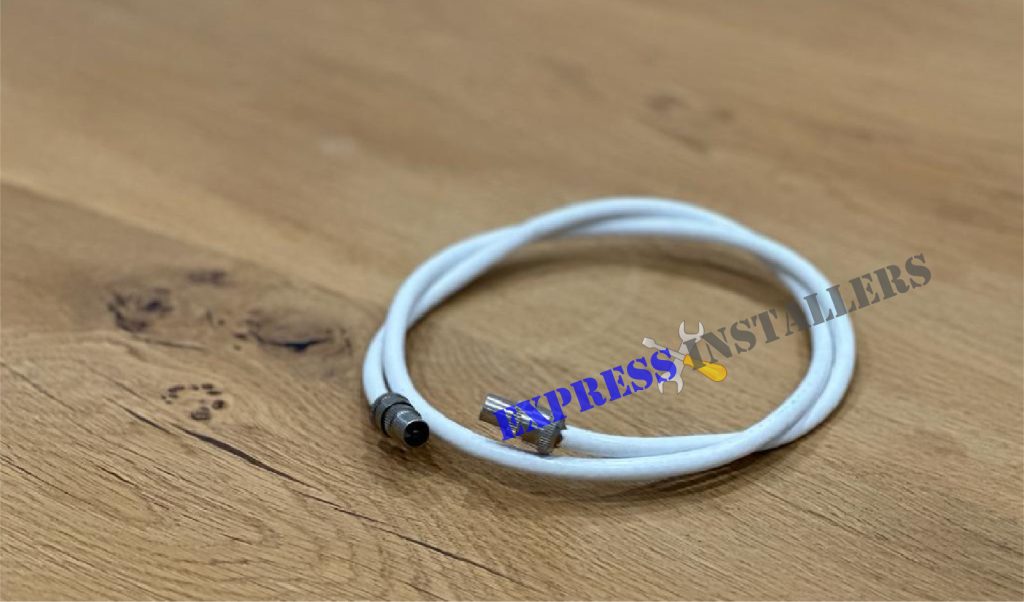
An aerial cable, sometimes called a coaxial cable, sends radio frequency signals from your TV antenna to your television.
It enables you to receive over-the-air HD signals for your television, making it a necessary part of any setup.
TV aerial cables are essential to guarantee a reliable and excellent signal transmission from the aerial.
The clarity of your TV reception may be affected by the kind of aerial cable you use.
Here’s a description and range of TV aerial cables:
Description: RG6 coaxial cables are made especially for high-frequency uses. They have thicker insulation and a central conductor than RG59 cables.
Advantages: RG6 cables are well-suited for high-frequency applications and long cable lengths because they provide superior signal quality and lower signal loss. They are also suitable for computer networks.
Use Cases: Perfect for broadband internet connections, satellite installations, and digital and high-definition TV signals.
Description: RG59 is an older standard for coaxial cable used for analogue transmissions. Its central conductor and insulation are thinner than those of RG6 cables.
Advantages: RG59 cables are still appropriate for shorter cable runs and analogue applications despite being less frequently used for modern-day digital signals.
Use Cases: Satellite TV installations, closed-circuit television (CCTV), and analogue signals.
Description: These cables are composed of two parallel wires, usually made of aluminium or copper, and an insulating layer of foam or plastic between them.
Advantages: Twin lead cables are reasonably priced and highly flexible. They work well for transmitting signals over short distances.
Use Cases: These were historically used for older sets, particularly those that had antennas built in. They are less typical of contemporary setups.
Description: Flat ribbon cables consist of multiple flat conductors connected in parallel, typically in the shape of a ribbon.
Advantages: Flat ribbon cables can be more easily concealed or routed in small areas due to their compact size. They work well for indoor installations.
Use Cases: Suitable for indoor antenna connections and short cable runs.
Description: F-type cables are coaxial cables with a specific F-type connector for satellite and cable TV connections.
Advantages: F-type cables offer a dependable and safe connection. They are widely utilised for digital signals nowadays.
Use Cases: Suitable for connections from cable and satellite, along with specific installations of digital antennas and outdoor TV.
When choosing an aerial cable, various aspects should be taken into account, including the distance between the antenna and the TV, the kind of signals being transmitted, and the particular needs of your TV setup.
Selecting the appropriate cable and TV accessories guarantees a reliable viewing experience and maximum signal quality.
TV aerial cables work by receiving signals transmitted over the air, relaying them through wiring, and dividing them into multiple rooms if necessary.
Cable connections are used to transmit these signals to our TVs.
Typically, TV aerials are mounted on a building’s roof or in a loft to maximise reception and range. Specific aerials can be installed in your loft as well.
When buying an aerial cable, it’s important to choose the required length to suit your needs. Cables and accessories are available in various lengths, from 1 meter to 25 meters.
A 1-meter Philex coaxial cable costs as little as £2, while a 10-meter TV aerial right angle with plug adapter can cost about £14.
Aerial connectors attach your TV to an antenna, also known as a coaxial connector or coupler.
They transport data and video signals from the aerial to your TV. Coaxial connectors come in a variety of forms, including:
7/16 DIN
BNC
MCX
QMA
RCA
SMB
Typically, these connectors are mounted on a building’s roof or in an attic area to optimise reception range.
They work by receiving signals that are transmitted over the air, relayed through wiring, and, if necessary, divided into multiple rooms. The signal is then conveyed to screens via cable connections.
Depending on your aerial plug, various TV aerial connectors are available for purchase, including male-to-male, female-to-female, and male-to-male.
For example, you can find products like the “OBYJCA Aerial Connectors 5 PCS, 2X Female & 2X Male TV Aerial Connector Coaxial Cable Connectors Adaptor, Aerial Adapter, F Connector Adaptor,” on Amazon UK for £3.79.
Other options include the “Bingfu TV Aerial Adapter F Type To Coax Adapter Connector F-Plug To Coax Plug And F-Plug To Coax Coupling (Pack Of 2) For Antenna Cables, Aerial” for £4.98.
And the “TV Aerial Connectors, XCOZU 10 Pack Metal TV Coaxial Cable Connectors Male To Female, 5 Female & 5 Male TV Aerial Cable Adapter F Connector Adaptor,” for £5.89.
Note that if the cables are too long, typically 10m and above, a TV signal booster will be required to keep a good signal and avoid disruption.
To sum up, a TV aerial cable is an essential component of your home entertainment system.
It makes it possible for you to continuously watch your favourite shows while receiving over-the-air television signals.
When purchasing an aerial cable, consider the type of cable, the length you need, and the price to suit your budget.
Mon-Fri: 24 Hours
Sat: 24 Hours
Sun: 24 Hours